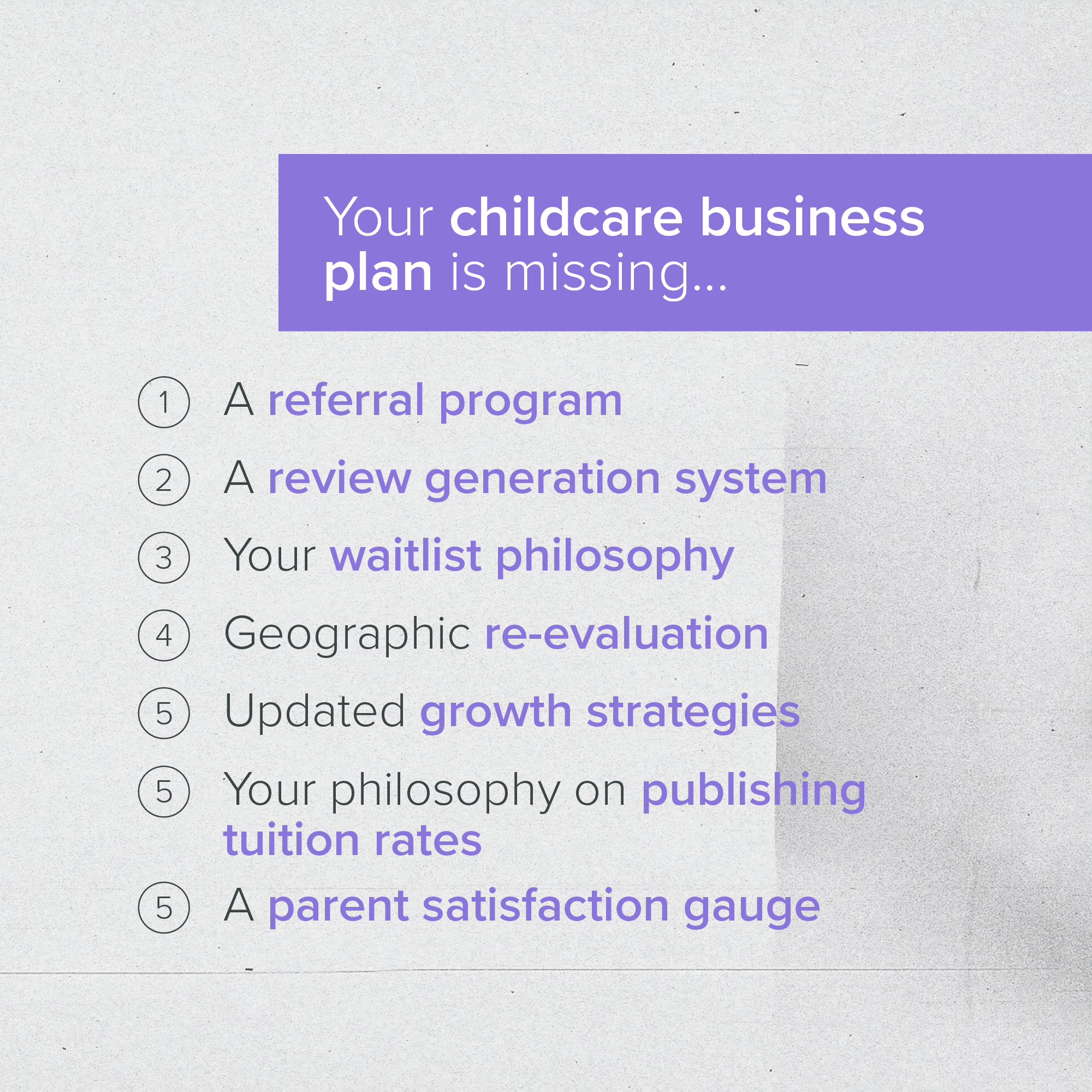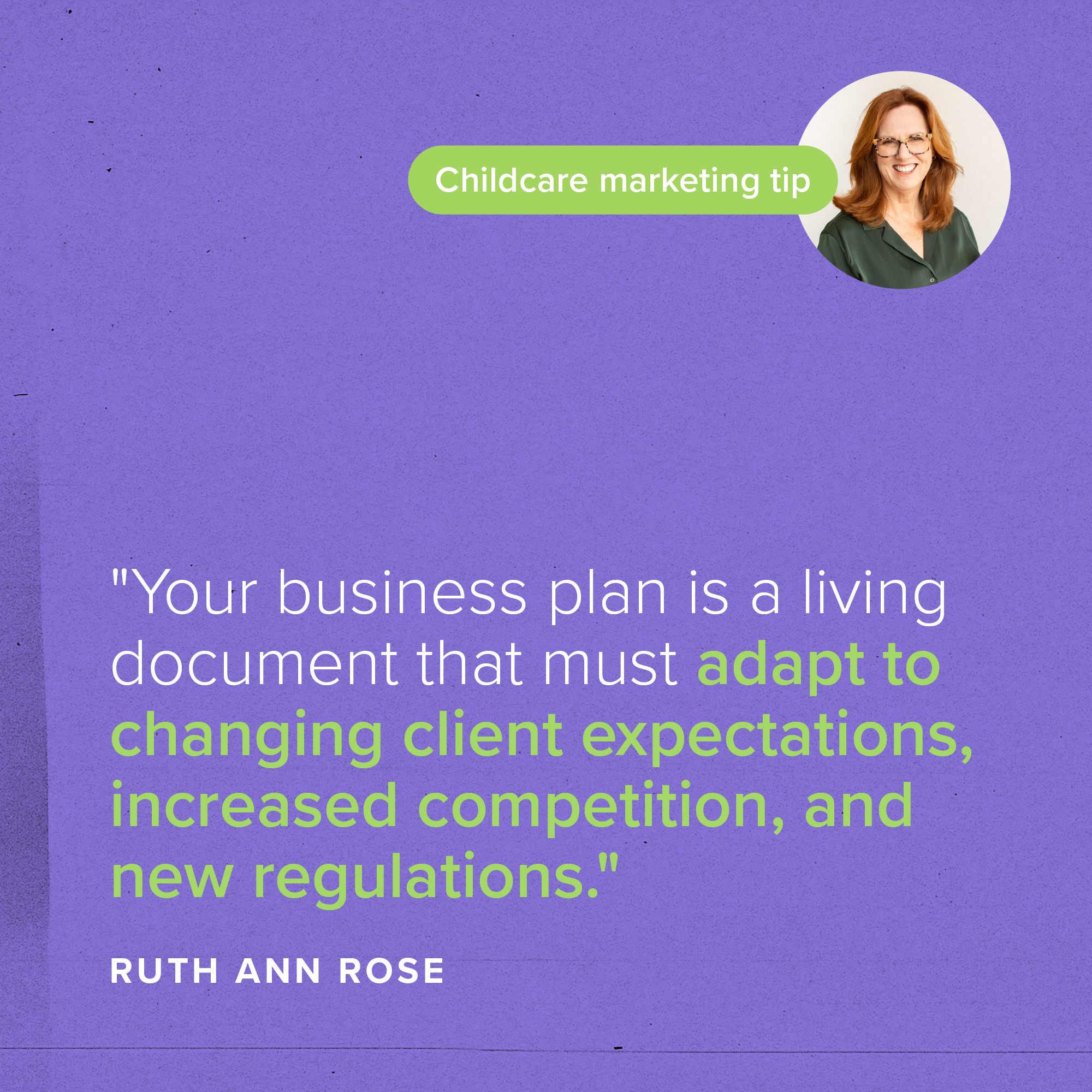Every business owner needs a vision — a documented plan — that outlines the direction their business is headed and the steps to take to arrive there.
A business plan enables you to make vision-driven decisions, align staff with your objectives, and determine future financial needs. Without it, you position your business for failure.
Childcare organizations are no different. Your daycare business plan is the document that steers your organization toward your goals — but is your existing plan complete?
Why Your Daycare Business Plan Deserves Regular Updates
As your industry, the economy, and the people you work with change, your approach to business and your business goals might change, too. That means your business plan needs updates.
A daycare business plan is a living document that must adapt to changing client expectations, increased competition, and new regulations. Update your plan to reflect those changes as factors shift. That way, your business stays up-to-date, your staff stays on the same page, and your school’s success is ensured.

7 Things Your Daycare Business Plan May Be Missing (and Why You Should Include Them)
The following seven items should be in your daycare business plan, but owners sometimes forget to include them. We strongly encourage you to add them if you haven’t already and share them with your staff and stakeholders.
1. A Referral Program
When you’re successful with a family, you want more families like them. It helps build a sense of community and is one of the least expensive ways to attract prospects.
When people enjoy their experience, they’re usually more than happy to tell others about the school without any kind of reward. However, thank-yous help them feel validated and appreciated.
Make it easy for enrolled families to encourage others to visit your center. Cash and tuition discounts have been effective rewards in the past, but we’ve heard recently that gifts of “dinner and a movie” have been a big hit with families.
When you’re ready to offer incentives for referrals, be sure to nail down the following:
- How you communicate the desire for referrals (your message)
- How you communicate the rewards for referrals (your incentive)
- How you track the outcome of referrals
Tracking is imperative. You must track who earns rewards and whether their referrals stick around so you know if your rewards system is successful.
2. A Review Generation System
Consistently generating reviews is essential. Prospective families want to know what’s happening at your school currently, not months or years ago. Recent reviews also influence organic search traffic and search engine rankings.
To generate reviews, you need a strategy (and possibly tools and software). Taking advantage of happy experiences and making leaving a review as convenient as possible are two great strategies you can employ today.
Families participating in happy events, like kindergarten graduation or Grandparents’ Day, are more likely to share those happy experiences. Take advantage of that by sharing a convenient QR code that takes them to a review site or by sending a text or email with a link to leave a review. Make reviewing simple and convenient.
3. Your Waitlist Philosophy
How does your school approach waitlists? Include this policy in your daycare business plan and update it as needed. For example, many business owners use artificial waitlists based on staff shortages rather than capacity.
Maintain waitlisted families’ interest in your school through continued education (a form of marketing). Manage this with a drip email campaign.
If you have a waitlist due to limited capacity (as opposed to a staff shortage), it may be time to raise your prices (as per the principle of supply and demand). Include this in your daycare business plan so you don’t leave money on the table when you’re in high demand.
4. Geographic Re-Evaluation
When you started your business, you had a good idea of what area your marketing should target and where your families would likely live.
However, this area can change. When it does, it impacts (or should impact) your daycare business plan. Checking currently enrolled family addresses, creating a yearly heat map, and updating your target marketing area will ensure you don’t waste ad spend in places where your prospects don’t live
5. Updated Growth Strategies
Your daycare business plan probably has a documented marketing strategy that includes methods of attracting new families. However, those tactics can require change over time (in more than just target geography).
Your digital ads, website, and social media need periodic review to ensure relevance and compliance with current best practices.
Always include new growth strategies or tactics you plan to use in marketing, including the cadence for reviewing site performance and meeting with your digital ads team. Also, include a periodic review of your staff’s tour and phone skills. A good phone script, active listening skills, and a solid sales process are essential to your business’s success.
6. Your Philosophy on Publishing Tuition Rates
Weigh the pros and cons of displaying your tuition on your website. Publishing prices can help families qualify themselves, which saves your staff time talking to and disqualifying families that can’t afford your services.
Some owners decide against listing tuition because they want the opportunity to explain why the rate is worth the expense before sharing a number. Other schools list the tuition with a full explanation of what’s included. You have to decide for yourself what’s best for your school.
Do you want to increase the number of highly qualified leads who contact your staff? Or is it more important that prospects have the experience of touring, seeing your facility firsthand, and meeting your staff before hearing your pricing? Whatever you decide, document it in your daycare business plan.
7. A Parent Satisfaction Gauge
Surveying families at specific points in their journey helps you determine whether you need to change your business strategy or offerings.
Plan when to check in (e.g., at the end of their first day, after six weeks, and after six months). Write a list of questions to ask and decide what software or tools to use.
Include the SOP (standard operating procedure) for the survey process in your daycare business plan and update it as needed.

Write Your Daycare Business Plan
Use the tips listed above to write or amend your daycare business plan. Update it regularly (at least once a year) and share it with your staff.
It’s a living document that keeps your business alive and well. Don’t let it go stale.
If you’d like help reviewing your business plan or writing a new one, schedule a Power Hour with us. We’re excited to help!
Subscribe
Sign up with your email address to receive news and updates.

